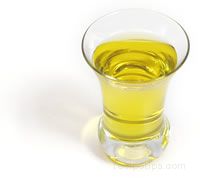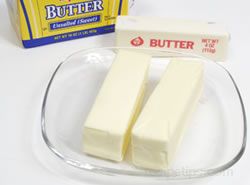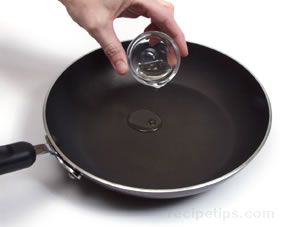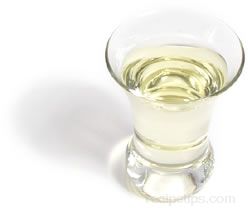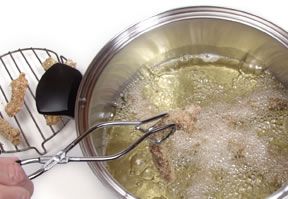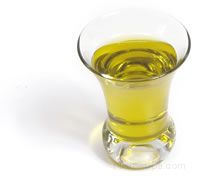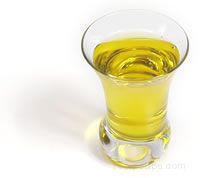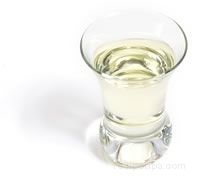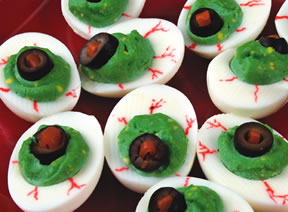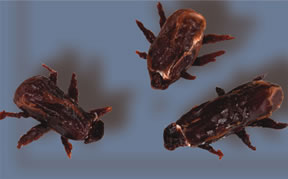|
Most of the edible fats described below are solid or semisolid at room temperature and most are from animal sources. A small number of plant fats are also naturally solid or semisolid at room temperature. Plant fats that are usually liquid at room temperature can be transformed into a solid fat if they undergo a process called hydrogenation in which hydrogen is added to the plant oil. This changes the chemical characteristics of the oil, making it solid at room temperature. The process also creates trans-fatty acids, which transforms the healthy plant oils, composed largely of unsaturated fat, into less healthy solid fats containing a high level of saturated fat. | |
|
Butter Brown Butter
Common Uses: flavoring condiment Clarified Butter
Common Uses: ingredient in baked dishes and sauces, condiment Ghee
Common Uses: cooking, ingredient in baked dishes and sauces, condiment Lactic Butter
Common Uses: cooking, baking, condiment, ingredient for sauces, flavoring ingredient Sweet Butter
Sweet butter may be sold salted or unsalted. Many people mistakenly believe that "unsalted butter" is the only type of sweet cream butter (because of the absence of salt) and "salted" butter refers to a product that is entirely different, when actually both products are identical except for the salt. Any butter produced with sweet rather than sour cream is known as sweet cream butter. Both unsalted and salted butter are popular for everyday use, but unsalted butter is preferred for the preparation of sweet dishes. Butter is one of the most popular cooking fats, providing rich flavor to foods, but it has a low smoke point, so care must be taken not to burn it when using it for high heat sautéing and frying. When sautéing with butter, many cooks add an oil with a higher smoke point to prevent the butter from burning. Butter is used as a topping for breads and rolls, is melted onto cooked vegetables, and is added to many types of sauces to provide a rich, smooth flavor. It is also used as an ingredient in hundreds of baked goods such as breads, rolls, cakes, and pastries. Butter is inspected and graded by the United States Department of Agriculture (USDA). The flavor, color, texture, body, and salt are among the criteria used by the USDA for grading. The grade consists of a letter grade and sometimes a numerical score such as AA or a score of 93, which is the best. Other grades include A, or a 92 score, B, or a score of 90, and C, representing a score of 89. Usually only Grade AA and Grade A are found in food stores. Butter is perishable so it should be stored in the refrigerator. It should be tightly wrapped because it will absorb odors and flavors quite easily. Unsalted butter may be kept in the refrigerator for 2 or 3 weeks and salted butter may be kept somewhat longer (4 or 5 weeks) because the salt acts as a preservative. Butter freezes extremely well and may be kept in the freezer for long-term storage for at least a half year. Common Uses: cooking, baking, condiment, ingredient for sauces, flavoring ingredient Whey Butter In order to produce whey butter, the whey is drained from the cheese curds during the cheese making process. Any cream remaining in the whey is separated and churned into butter. Whey butter is strong and salty with a cheese flavor and it has limited appeal. It can be found in some specialty shops and farmers markets. Common Uses: condiment, flavoring ingredient
| |
|
Cocoa Butter Cocoa butter is a cream colored vegetable fat that is obtained from cocoa beans, usually as a byproduct during the production of chocolate and cocoa powder. It is used as a flavoring for various foods and it is also used in the cosmetic industry for the manufacture of soaps and lotions. It is very high in saturated fat so it should be used sparingly. Common Uses: chocolate and cocoa powder production, cosmetics | |
|
Coconut Oil
In the United States, coconut oil is most often used in commercially prepared products such as cookies, candies, ice cream, whipped toppings, and nondairy coffee creamers. Coconut oil is also used in the manufacture of various cosmetics, soaps, lotions, and suntan oils and is very beneficial in maintaining healthy skin. Coconut oil contains a high level of saturated fat (92%). It is generally agreed among nutritionists and health professionals that foods with high levels of saturated fats should be avoided, but this may not be true with coconut oil. There are several studies that have indicated that the saturated fat in coconut oil metabolizes in the body similar to an unsaturated fat and as a result, LDL (bad) cholesterol will not increase. It has been suggested that coconut oil is much like a carbohydrate: it digests rapidly and it is used for immediate energy rather than being stored as fat. As a result, a greater quantity of coconut oil can be consumed before it is stored as fat. Some studies have indicated that adding coconut oil to the diet may contribute to weight loss because it satisfies hunger and decreases the appetite. People who have problems in receiving adequate nourishment, such as AIDS patients, have benefited from the addition of coconut oil to their diets. There is also evidence that because coconut oil is digested much like a carbohydrate, it may improve athletic performance and endurance. Despite all of the studies and individual testimonials, there are an equal number of health professionals and organizations that disagree with the claims of the positive effects associated with coconut oil. In promoting healthy food choices, both the USDA and the FDA recommend a diet low in saturated fat and the American Heart Association is skeptical concerning the studies indicating the health benefits of coconut oil. It is evident that more scientific studies will be necessary before the claimed health benefits of coconut oil can be proven. Common Uses: commercial baked goods, candy and sweets, commercially prepared whipped toppings, nondairy coffee creamers, shortening production, soaps, cosmetics, lotions, suntan oil | |
|
Lard
Like butter, lard will absorb flavors and aromas so it should be tightly wrapped when it is stored. The label should be checked for the proper storage method because some types of lard, depending on the processing technique, may be stored at room temperature, while other types require refrigeration. Common Uses: baking, frying | |
|
Margarine
In order to produce margarine in a solid form, the vegetable oil must undergo hydrogenation, which is a process that adds extra hydrogen to the oils. This process changes the chemical composition of the vegetable oils resulting in the oils becoming a solid at room temperature. The hydrogenation process also produces trans-fatty acids, which converts the healthy unsaturated fats of the vegetable oils into solid saturated fats. This characteristic makes many of the margarines on the market no better or worse than butter in terms of nutrition and health. When shopping for margarine, look for brands that are low in trans-fatty acids. Margarine can be used similar to butter as a topping for bread, rolls, biscuits, or vegetables. It is much more spreadable than butter when used directly from the refrigerator. Margarine is often used in a variety of baked goods and can be used in any recipe requiring butter. It has a lower smoke point than many cooking oils and fats so it is usually not the first choice for sautéing or frying. Other types of margarine include:
Margarine should be stored in the refrigerator where it will keep for 2 months or more and for long term storage, it may be kept in the freezer for a half year or longer. Like butter and other solid fats, margarine will absorb the flavors and odors of other foods so it should be tightly wrapped or covered when storing. Common Uses: cooking, baking, condiment | |
|
Suet
Common Uses: steamed puddings, candles | |
|
Vegetable Shortening
Like lard, vegetable shortening is very useful in baking light and flaky pastries. Some varieties may have butter flavoring added, which improves the flavor and gives the shortening a light golden color. Vegetable shortening can be stored at room temperature for a year or more if it is tightly covered. Common Uses: baking, frying
|
Loading
Types of Edible Solid Fats

Provided By
RecipeTips
RecipeTips

Loading
There currently aren't any reviews or comments for this article. Be the first!
Advertisement
Advertisement

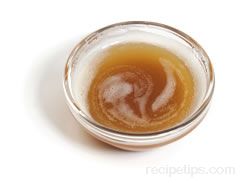


 Clarified butter is produced by melting regular butter over low heat and skimming off the milk solids that rise to the top. The golden yellow clarified layer is then strained off, leaving only sediments in the bottom of the pan. Clarified butter has a rich buttery flavor and is excellent for cooking because it has a higher smoke point than regular butter. It is used in many baked dishes and for creating a variety of sauces. Clarified butter is also known as drawn butter and is often used as a dipping sauce for various types of seafood, such as shrimp and lobster.
Clarified butter is produced by melting regular butter over low heat and skimming off the milk solids that rise to the top. The golden yellow clarified layer is then strained off, leaving only sediments in the bottom of the pan. Clarified butter has a rich buttery flavor and is excellent for cooking because it has a higher smoke point than regular butter. It is used in many baked dishes and for creating a variety of sauces. Clarified butter is also known as drawn butter and is often used as a dipping sauce for various types of seafood, such as shrimp and lobster. Originating in India, ghee is a form of clarified butter that is made from a strongly flavored cream. After the butter from the cream is clarified, it is allowed to remain on the heat for a longer period, which results in a darker, caramelized, strongly flavored butter. It has a very high smoke point, making it useful for high heat cooking methods. Ghee, which is usually sold in cans, does not have to be refrigerated because it contains no milk solids that can spoil.
Originating in India, ghee is a form of clarified butter that is made from a strongly flavored cream. After the butter from the cream is clarified, it is allowed to remain on the heat for a longer period, which results in a darker, caramelized, strongly flavored butter. It has a very high smoke point, making it useful for high heat cooking methods. Ghee, which is usually sold in cans, does not have to be refrigerated because it contains no milk solids that can spoil.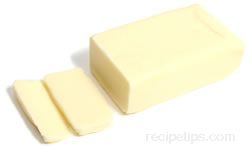 One of the two basic types of butter is lactic butter (the other main type is sweet butter). It is produced from cream that is pasteurized, cooled, and inoculated with a lactic acid producing bacteria (starter culture). The culture ripens the butter and at the appropriate time, the butter is pasteurized again to stop the ripening process. Lactic butter is favored in many European countries where the rich flavor of the butter is preferred. Lactic butter has a higher smoke point than sweet cream butter, which makes it excellent for sautéing. It also has a lower moisture content, which is preferred by European bakers since excess moisture in butter can affect baking results. Lactic butter is also referred to as ripened butter.
One of the two basic types of butter is lactic butter (the other main type is sweet butter). It is produced from cream that is pasteurized, cooled, and inoculated with a lactic acid producing bacteria (starter culture). The culture ripens the butter and at the appropriate time, the butter is pasteurized again to stop the ripening process. Lactic butter is favored in many European countries where the rich flavor of the butter is preferred. Lactic butter has a higher smoke point than sweet cream butter, which makes it excellent for sautéing. It also has a lower moisture content, which is preferred by European bakers since excess moisture in butter can affect baking results. Lactic butter is also referred to as ripened butter. Sweet butter, which is simply referred to as "butter", is produced from cream that has been churned until it becomes semisolid. It is one of the two main types of butter (the other is lactic butter). Any type of milk can be used, but cow's milk is the most popular. In the United States, any product labeled sweet butter must contain at least 80% milk fat. Water and milk solids are the remaining components.
Sweet butter, which is simply referred to as "butter", is produced from cream that has been churned until it becomes semisolid. It is one of the two main types of butter (the other is lactic butter). Any type of milk can be used, but cow's milk is the most popular. In the United States, any product labeled sweet butter must contain at least 80% milk fat. Water and milk solids are the remaining components.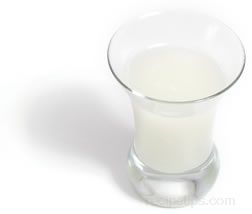 Coconut oil is extracted from the dried meat of the coconut and is very popular in India and Southeast Asia. Unlike most other oils obtained from plant sources, it solidifies at room temperature and has a buttery texture.
Coconut oil is extracted from the dried meat of the coconut and is very popular in India and Southeast Asia. Unlike most other oils obtained from plant sources, it solidifies at room temperature and has a buttery texture. Lard is pork fat that has been rendered and clarified to produce a product that is firm and evenly textured with a mild flavor. Lard that is not processed has a soft, greasy texture and a strong flavor. Processing methods include bleaching, filtering, and hydrogenation. The fat around the kidneys produces lard with the best quality. At one time, lard was extremely popular as an all-purpose cooking fat and for use in baking. It has become much less popular because of the health problems associated with the overuse of saturated fat in the diet. However, it is still preferred by many pastry cooks because it produces the most tender and flaky crusts. Some cooks add butter to lard when making pastries in order to make the crust more flavorful.
Lard is pork fat that has been rendered and clarified to produce a product that is firm and evenly textured with a mild flavor. Lard that is not processed has a soft, greasy texture and a strong flavor. Processing methods include bleaching, filtering, and hydrogenation. The fat around the kidneys produces lard with the best quality. At one time, lard was extremely popular as an all-purpose cooking fat and for use in baking. It has become much less popular because of the health problems associated with the overuse of saturated fat in the diet. However, it is still preferred by many pastry cooks because it produces the most tender and flaky crusts. Some cooks add butter to lard when making pastries in order to make the crust more flavorful. Margarine has been a popular butter substitute for over a hundred years. Like butter, regular margarine must contain a minimum of 80% fat. It is made from various vegetable oils such as soybean and corn.
Margarine has been a popular butter substitute for over a hundred years. Like butter, regular margarine must contain a minimum of 80% fat. It is made from various vegetable oils such as soybean and corn.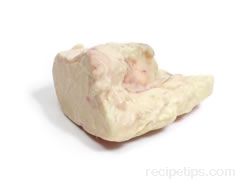 Suet is a white, solid fat obtained from the area surrounding the kidneys of beef and sheep. It is used for the creation of dumplings and for several traditional English steamed puddings, such as steak and kidney pudding. It is also used in the manufacture of tallow candles. It was very popular at one time, but it has lost much of its popularity due to increased awareness of health problems associated with saturated fat. Suet is sold in large chunks or in a shredded form in small packets.
Suet is a white, solid fat obtained from the area surrounding the kidneys of beef and sheep. It is used for the creation of dumplings and for several traditional English steamed puddings, such as steak and kidney pudding. It is also used in the manufacture of tallow candles. It was very popular at one time, but it has lost much of its popularity due to increased awareness of health problems associated with saturated fat. Suet is sold in large chunks or in a shredded form in small packets.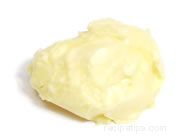 Made from vegetable oils, vegetable shortening is a solid fat at room temperature because of a process called hydrogenation in which hydrogen is added to the oils. This changes the chemical characteristics of the oils, making them solid at room temperature. The process also creates trans-fatty acids, which transforms the healthy oils, composed largely of unsaturated fat, into less healthy fats containing mostly saturated fat.
Made from vegetable oils, vegetable shortening is a solid fat at room temperature because of a process called hydrogenation in which hydrogen is added to the oils. This changes the chemical characteristics of the oils, making them solid at room temperature. The process also creates trans-fatty acids, which transforms the healthy oils, composed largely of unsaturated fat, into less healthy fats containing mostly saturated fat.
